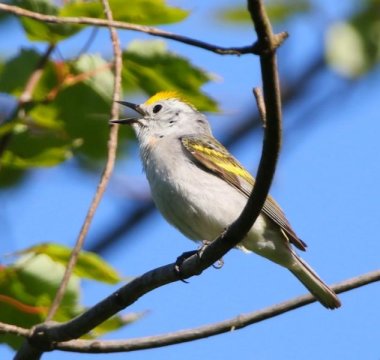[ad_1]
Scientists have shown that a bird found in Pennsylvania is the offspring of a hybrid warbler mother and a warbler father from an entirely different genus — a combination never recorded before now and which resulted in a three-species hybrid bird. This finding has just been published in the journal Biology Letters.
“It’s extremely rare,” explains lead author and Cornell Lab of Ornithology postdoctoral associate David Toews. “The female is a Golden-winged/Blue-winged Warbler hybrid — also called a Brewster’s Warbler. She then mated with a Chestnut-sided Warbler and successfully reproduced.”
A dedicated bird watcher and contributor to eBird.org in Roaring Spring, Pennsylvania, first noted the oddity in May 2018. Lowell Burket says he spends time birding and relaxing in the woods on family-owned property where he also likes to take photos and video of birds. In one piece of video he noticed a male bird that sang like a Chestnut-sided Warbler but had some of the physical characteristics of both Blue-winged and Golden-winged Warblers. Burket saw the bird again a number of times, reported it to eBird, and got in touch with researchers in the Cornell Lab’s Fuller Evolutionary Biology Lab.
“I tried to make the email sound somewhat intellectual so they wouldn’t think I was a crackpot,” Burket recalls. “Having the photos and video helped. Within a week researcher David Toews came down. We found the bird again and collected a blood sample and measurements. It was a very interesting and exciting morning for us. A few days later I got a text message from Dave saying, ‘You were right!!!'”
The key to identifying the triple-hybrid’s parents came from genetic analyses.
“We looked at the genes that code for different warbler colors,” Toews explains. “This way we could recreate what the hybrid’s mother would have looked like — the avian equivalent of a detective’s facial composite, but generated from genes. We confirmed that the mother would have looked like a Brewster’s Warbler and the father was a Chestnut-sided Warbler.”
Hybridization is common among Golden-winged and Blue-winged Warblers, and this has been of particular concern for Golden-winged Warblers which have declined dramatically in some populations. But hybridization has never been recorded between these species and Chestnut-sided Warblers. This kind of rare hybridization event may also occur more often in the declining warbler populations of Appalachia, because there is a smaller pool of mates from which to choose.
“That this hybridization occurred within a population of Golden-winged Warblers in significant decline suggests that females may be making the best of a bad situation,” says Toews. “It also tells us that wood-warblers in general have remained genetically compatible long after they evolved major differences in appearance.”
Will the bird’s mixed ancestry confuse potential mates and make him a pariah or will he be able to find a mate and successfully produce offspring? Scientists are going to keep an eye on this location to see what the future may hold for this very rare bird. And Lowell Burket declares he’s a bird watcher for life.
“I had literally zero knowledge about birds until seven years ago,” he says. “And now I end up discovering what appears to be a first-of-its-kind bird. It can happen to anybody!”
Story Source:
Materials provided by Cornell University. Note: Content may be edited for style and length.
[ad_2]















